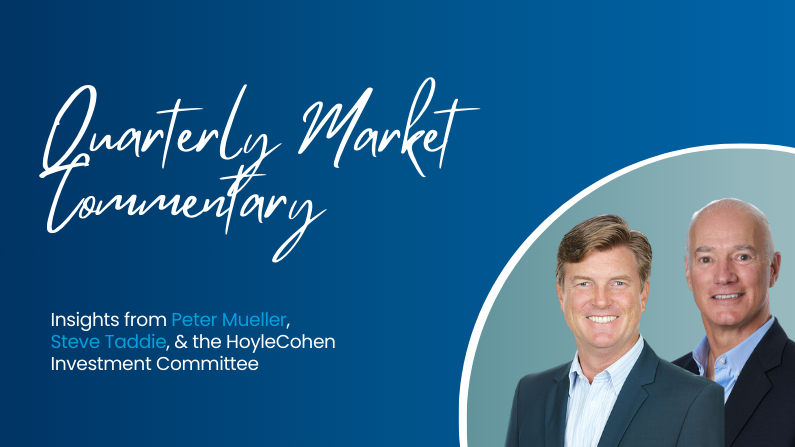Goldilocks – is the economy just right?
By, Steve Taddie, Peter Mueller, & the HC Investment Committee
The Standard & Poor’s 500 (S&P 500) stock index continued its ascent in the 2nd quarter, despite a brief hiccup in the first half of April. For the quarter, the S&P 500 outdistanced all but the emerging market stock index by a wide margin, as US growth stocks delivered solid 1st quarter earnings and valuation multiples expanded. The joy was not shared by international large- and mid-cap stocks, or domestic mid- and small-cap stocks. Those shares struggled with declining valuation multiples during the quarter, and indexes finished the quarter slightly lower. Longer-term bond yields, after rising rapidly in the 1st quarter peaked in April, then retreated during the latter part of the quarter as two successive month-to-month inflation readings showed slowing inflation. For the quarter, the S&P 500 finished about 4.25% higher, sporting a Price to Earnings (PE) ratio of about 21, and the 10-year US treasury bond yield, which varied a bit during the quarter, finished fractionally higher at 4.34%.
It is an interesting time for the US economy and the investment markets. As the Federal Reserve strives to “get it right,” we continue along the path from unprecedented stimulus to normalized policies and expect to have some brushfires of not so good data or not so perfect policy decisions along the way. The key is to not allow these short-term situations to distort one’s view of longer-term trends. So far, so good, as Federal Reserve policy is concerned, but varied lag times with respect to economic policy and economic activity, makes patience a hard virtue for investors to practice. The Fed is on a tightrope, too tight for too long curtails employment strength and causes a recession, which negatively impacts stock market values. Then the ensuing “rescue” policy of rapid interest rate reductions lowers interest income, creating a sort of negative feedback loop that can feed on itself. Loosening too soon, could lead to a lasting rebound in inflation, which has its own implications. Also, let us not forget about fiscal policy, which the Fed does not control, but must contend with. For the US to “get it right” monetary and fiscal policy need to work in unison. It is challenging to expect the Fed to orchestrate a perfect landing (controlled inflation without a recession) if the Executive and Legislative branches of government enact policies that heat up or cool down economic activity which may run counter to Fed policy goal of stable prices and full employment.
Economic growth, while slowing a bit, should continue to surprise many economists, supported by stable to rising consumer income. Employed consumers with rising real wages and retired consumers spending higher interest incomes continue to bolster economic activity. While valuations in the financial markets are not cheap, the expectation for declining inflation pressures coupled with the prospect of improving productivity via the application of artificial intelligence technology are expected to help companies meet or beat revenue and earnings estimates. The increasing number and magnitude of global conflicts seem to run in the background and have not materially impacted US financial markets. No comment on whether this is right or wrong, it is simply where we find ourselves at present.
The presumption of more predictable economic activity and improved productivity plays out in earnings expectations, with 2024 and 2025 S&P 500 companies’ EPS (Earnings Per Share) estimates at +11.5% and +14.4% respectively. Falling interest rates (Fed Funds Rate) and a normalizing yield curve should contribute to the financial health and earnings growth prospects of mid- and small-cap stocks. This should put them in a better position to perform more in-line with or outperform their large-cap growth stock brethren.
Turning an eye to the bond market, we look to the yield curve. The yield curve is simply a graph of yields by maturity and connecting the dots from 1 month to 30 years of data which creates a line, or curve. The shortest-term yields have been higher than longer-term yields for more than one year, creating what is called an inverted yield curve. When the Fed lowers interest rates, other short-term interest rates will follow, causing the yield curve to flatten, then, as those rate cuts continue the yield curve will normalize, with longer-term yields being higher than shorter-term yields. Neither will it happen in perfect sync with Fed rate cuts, nor will it be a perfectly smooth curve as nuances exist in every market. But, with short-term rates expected to fall below longer-term rates, those portfolios relying on interest income to obtain investment objectives will require an active role in bond management to maintain desired income levels.
In sum, today’s climate of rising earnings expectations, falling short-term rates, and more predictable economic activity may prove to be just right – not a bad backdrop for investment markets. Stay tuned regarding productivity and profit margin improvements, as those issues support most earnings growth assumptions.
All the best,

Stephen J. Taddie, CBE® CFM

Peter Mueller, MBA, CFP®
For a downloadable version of this quarterly commentary click here.
If you have questions about this or any other planning or investment related topics, please reach out to your advisor.
The information provided here is general in nature and is shared for information purposes only; nothing herein should be interpreted as investment or tax advice. Any and all tax laws and/or specific tax rates referenced are subject to change. It should not be assumed that future performance of any specific investment or investment strategy will be profitable. Always consult your CPA/tax advisor/attorney (or reach out to us;) to discuss your specific situation. All investments carry the risk of loss, including the permanent loss of principal. Past performance is no guarantee of future results.

